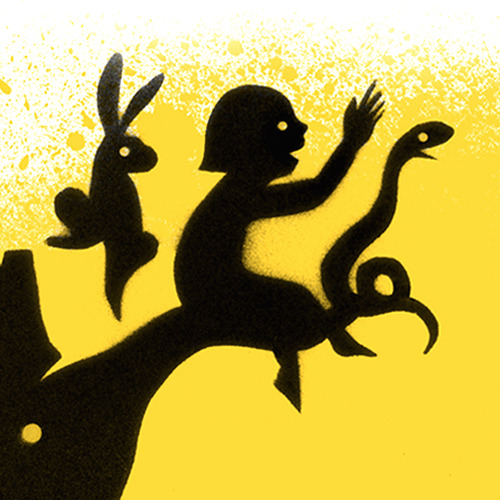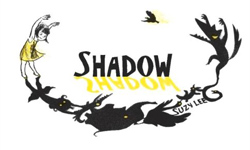< Back to posts
Suzy Lee
Korea

Suzy Lee graduated from Seoul National University with a BFA in Painting, before heading to London to pursue a Masters in Book Arts at Camberwell College of Arts. Since then, she's created a selection of award-winning picturebooks which have been published all around the world. Suzy lives and works in Korea.
In this post, Suzy talks about how she made the brilliant ‘Shadow’, the third title in her hugely successful ‘Border Trilogy’. This inventive picturebook, which celebrates the power of imagination, was a New York Times Best Illustrated Book of the Year.
Suzy: I love everything about ‘the book’.
I love the great story in the book and I love the book as an object. The physical elements of the book are part of the story itself in some of my books...
‘Mirror’ (Corraini, 2003) is vertical and opens to the side.
‘Wave’ (Chronicle Books, 2008) is horizontal and opens to the side too.
These two books are the same size and they share the same idea: the centre binding of each of the book's left and right pages works as a border between fantasy and reality. I wanted to make one more book to complete the ‘Border Trilogy’.
So what form is left?
I thought that it should be horizontal like ‘Wave’...
But this time, I wanted it to open from bottom to top.
I made a blank dummy book and stared at it.
A book that opens from bottom to top – a top world and a bottom world divided by the border of fantasy and reality – a play made by the child alone – the child's creations coming alive...
The conclusion came easily: shadows.
Sometimes, the motivation for creating a book can come from the conditions of the book's structural form and not only from literary subjects.
The shadow is an attractive subject. It's black, flat, and it looks just like me and you. There are many interesting references. Here are some notes:
Notes: The myth of Narcissus / “Dinner's ready!” Mum called. The child went out of the room. But what if the shadow of the child couldn't catch up? What if the shadow was the other being from the start? / Wendy sewing a shadow onto Peter Pan's foot / ‘Melancholy and Mystery of a Street’ by Giorgio de Chirico.
So I started making some thumbnail sketches.
In the dark shed, with the click of a light bulb, a girl's imagination also lights up. She creates many shadows and plays with them.
Then I drew some images. In ‘Mirror’ and ‘Wave’, I used charcoal. Charcoal displays two traits simultaneously: the linearity of clear strong lines and the dynamic sense of volume through finger-blurring effects.
How to make the shadows then?
How to make proper textured shadows that could go with the girl's rough charcoal lines?
A shadow traces the contour of something. I felt that drawing by hand wouldn't express its distinctive lines. I had to think of another way to express the shadows while still maintaining their flat nature. Stencil seemed to be a good solution.
I cut all the characters out from the stencil papers. After cutting around the shadow outlines one by one, my fingers wound up curved in the other direction.
I played around with spray paint.
Spray paint is a very flexible medium. When sprayed on paper that has been fixed in place, the spray offers clear outlines; when the paper is slightly lifted when spraying, the shadow's movement and perspective become remarkable.
Next, I built up all the drawings and shadows together, digitally.
Then I added the colour. I chose yellow because it makes black stand out beautifully and clearly. Yellow shows the area of fantasy.
Back to the story. The girl has fun with the shadows she created. But the mischievous wolf attacks her and she runs away to the bottom world of shadows. And then, with the help of friends, she scares the wolf and the wolf bursts into tears.
But in fact, the wolf is also the girl herself. Everyone opens their hearts easily. The yellow that had existed only in the shadow world gradually crosses the border.
When the book got published, it was great to hear the readers' different ways of reading ‘Shadow’. Some said that you need to read it on your lap. If you place it at 90 degrees, the shadows look more convincing, as if they are cast on the floor.
Some said that you have to see both pages together to see the real and imaginary world at the same time.
Some said that you have to keep turning the book around. By rotating the book, you can even choose the part of the story that you want to see first. All methods of reading are possible because it's a ‘book’.
The most interesting feedback I've ever had was from a girl in kindergarten. She liked the all-black double-page spreads the most. Why?
When she casually flipped the pages, she saw another shadow through the black page because the light was behind it. She was able to catch the other shadow in the blink of an eye. Marvellous!
The readers always tell me their own method of reading books. And I think that's the charm of wordless picture books.
I had an exhibition recently in Korea, for which I made ‘My Shadow Theatre’. The audience made their own shadow puppets and a play which was shown on the screen.
The children in the audience stayed in the gallery for quite a long time. They came back again and again to play with their own shadow creatures.
Illustrations © Suzy Lee. Post edited by dPICTUS.
Shadow
Suzy Lee
Chronicle Books, United States, 2010
A dark attic. A light bulb. An imaginative little girl.
Suzy Lee's highly inventive picturebook perfectly captures the joy of creative play and celebrates the power of the imagination.


























